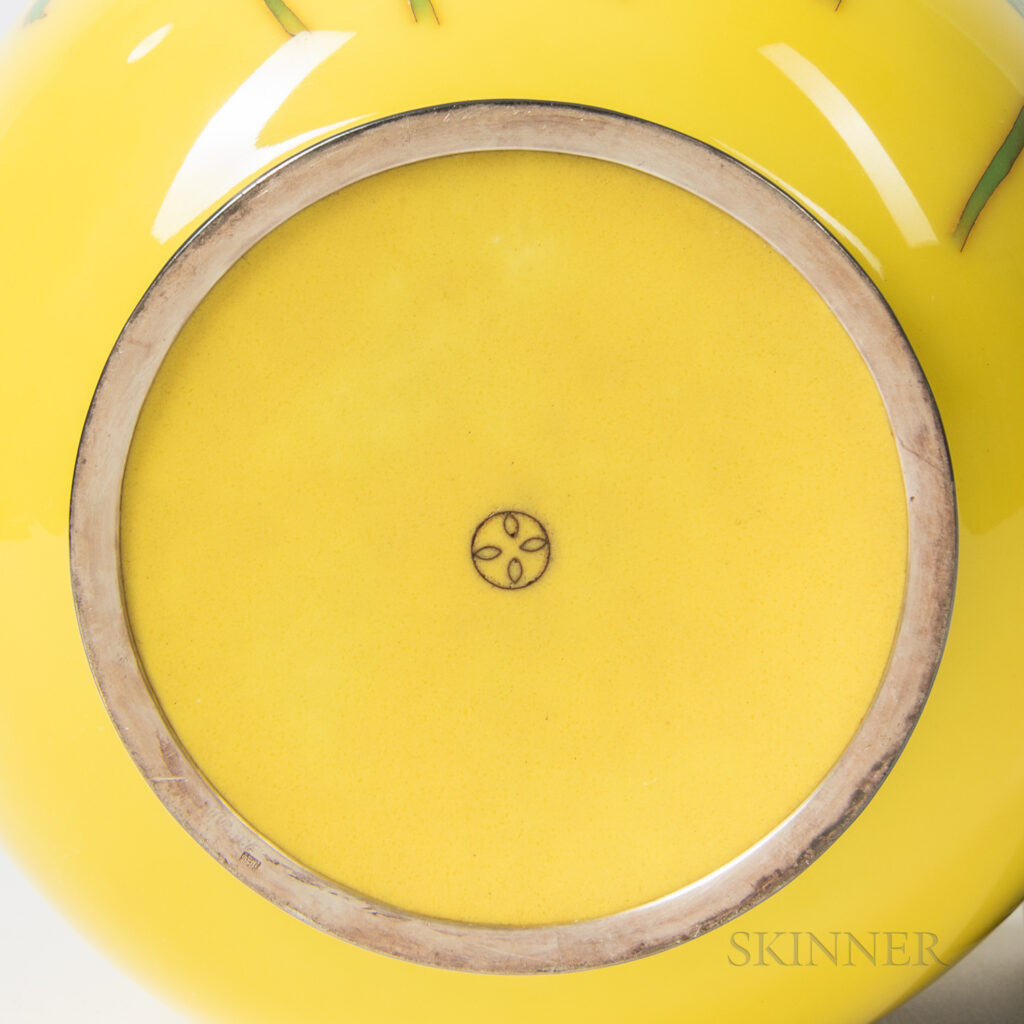Japanese cloisonné uses an ancient enameling technique originating in the West during the Middle Ages. The term cloisonné comes from the French cloison, meaning partition or segments, and refers to a form of decoration in which metal strips or wires are applied to a surface in closed shapes. Glass or enamel are melted into each partitioned area to create an elegant, jewel-like decoration. Initially, cloisonné adorned small portions of jewelry and metal accessories.
In China, cloisonné evolved as a significant art form. The Imperial palace workshop was the leading epicenter of high-quality cloisonné products, mainly produced to glorify temples and palaces. The color of early Chinese cloisonné works was predominantly turquoise blue. Over time, the palette expanded to included the whole color spectrum, as well as white and black. From these colorful Chinese cloisonné prototypes the modern Japanese cloisonné was born. Known in Japan as “shippo,” or “seven treasures,” skilled artisans achieved gem-like colors.
Japanese artists introduced many innovative techniques to cloisonné art. They achieved well-delineated colors and designs without wires. While the Chinese technique was generally applied to bronzes, Japanese artisans applied cloisonné to a variety of surfaces from bronze to clay and glazed porcelain. Japanese creatives experimented with new mediums and colors such as gold and silver speckles, foils, and pitch black. Above all, they added painterly designs to their repertoire making the Japanese cloisonné unique and different from the Chinese prototypes that employed mostly patterns and limited color palette of enamel.
The most noticeable difference between Japanese and Chinese cloisonné is the glassy surface. Japanese cloisonné is almost always finely ground and buffed to achieve this polished jewel-like transparency on the surface. Another striking difference is in the realistic design. On Japanese cloisonné, natural trees and flowers are preferred and realistically rendered (seen above) while Chinese works dominantly use auspicious symbols, such as dragons and lotus scrolls, in simplified patterns and designs (seen below).
Also unique to Japanese cloisonné is the use of colors, particularly in the background. Japanese artists use a single ground color in Japanese Art to contrast with the realistic scenes depicted and to provoke a poetic mood as seen in the example below, whereas Chinese artists used dominantly turquoise blue and rarely left their background blank in their Chinese Art, instead they are filled with a pattern or two.

We find another difference between the two in purpose and usage. Japanese cloisonné technique is applied to vessels of various shapes, often as an okimono for artistic enjoyment and appreciation, while Chinese cloisonné is applied to decorate variously shaped bronze animals, such as shishi, horses, and ducks, to ward off evil or to ensure good fortune.
In the current market, pieces from the so-called Golden Age of Japanese
cloisonné (1880-1910) are highly sought after. Unlike Chinese examples, almost all Japanese cloisonné works from this period bear the marks of their makers. These are usually placed on the underside of their bases. Ando Jubei (1876-1953) and his workshop are known for their use of well-defined silver wires, robust shapes, and bright colors as seen in this vibrant yellow example below.
The workshop of Inaba Nanaho (1831-1915) earned its fame for painterly designs using traditional painting subjects such as birds and flowers rendered against a dark ground.
Other notable workshops from this Golden Age include Namikawa Sosuke (1847-1910) (see below)

as well as Gonda (1865-1937) and Kumeno of Nagoya (1865-1939), to list but a few. The variety of forms, subjects, and styles are myriad, and we invite you to share works from your collection with us at asian@skinnerinc.com .







I have a cloisonne vase maked “japan”. When did they start marking cloisonne this way? Thank you, thank you, thank you.